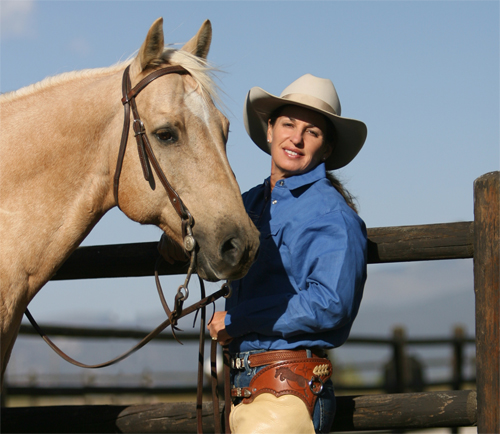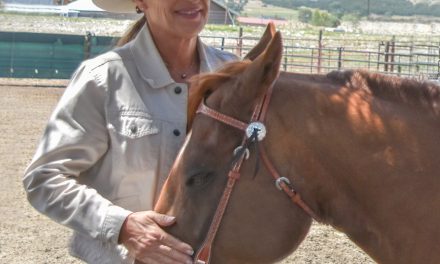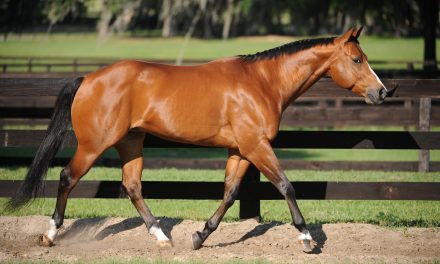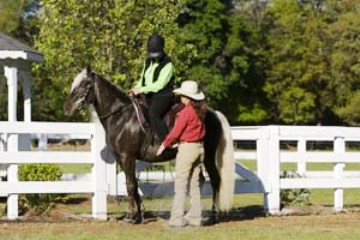Riding Right with Julie Goodnight
Dear Julie,

I have a 10-year-old horse that was born on my farm. From day one has been an ADD/spooky horse. He has been a challenge! Although we have made progress, it seems like I’m always going back to square one. My background is in dressage, but I do a lot of ground work too; some round pen, longeing, etc. I take him places, clinics and shows now and then, but I still struggle with getting his attention. Once in a while he’s kind of relaxed but progress is very slow. I can’t seem to get beyond the inattentiveness to really start being able to school him. What can I do to help him be calm and focused?
Finding the Focus
Dear Focus,
It sounds like you have already tried a lot of different things with this horse with limited success. At 10 years old, he ought to be getting pretty mature and reliable especially with all the work you have done. Without seeing you and your horse in action, it is hard for me to make a diagnosis, but I can make some suggestions, based on my experience in working with horses and people.
First you’ll need to teach your horse how to properly respond when something frightens him—we’ll replace his spooky behavior with stop, think and relax behavior.
Next, you’ll probably need to go back to basics in your ground work, paying special attention to your horse’s focus. Just doing ground work isn’t always productive, unless you’re going about it systematically, with a keen sense of awareness of what you’re trying to accomplish.
Finally, you’ll have to work on nose control with your horse, both from the ground and from the saddle. Just like a child with ADD, sitting at his desk and focusing on the teacher can be tough, but it can be learned, even without the Ritalin!
The correction:
I like to teach spooky horses to face their fear. As long as they face it they can stop and relax, and get lots of reassurance from me. So the first cardinal rule is that you must make sure your horse stops and faces the scary thing. When he’s afraid (instead of spinning and bolting), reward him. He’ll soon learn that when he stops he gets praise, a rub on the neck and gets to stop and relax.
Once he takes a deep breath and drops his head in relaxation, I’ll gently encourage him to move toward whatever he’s afraid of; I ask him to move forward one step at a time, stopping him with each step (so that I remain in control, issuing the orders, and so that he remains obedient) and rewarding him. This eventually becomes a game to the horse and he loves to work for the reward. He gets the ultimate reward when he will actually walk all the way up to the scary object and reach out and touch it with his nose. You can practice this exercise from the ground, too.
One big problem with a horse like this is that he doesn’t focus on you and doesn’t look to you for leadership. A focused and obedient horse—one that looks to your for direction, is best accomplished with groundwork, both lead line and round pen. It sounds like you have done a lot of this already, but I have seen a lot of people do ground work without succeeding in getting the horse’s total focus. For instance, the horse may run well around the round pen and do turns and stops, etc., but if his total focus isn’t on you almost all the time, then the round pen work may have been nothing more than meaningless chasing of the horse.
Once the horse is moving away from me well in the round pen and I can control which direction he goes, I want to establish a line of communication with him so that he’s constantly looking to me for directives. If his focus wanders outside the round pen, then I put him to work. Not harshly and not chasing him but asking him to do something like go faster, go slower, turn this way, turn that way, etc.
When his focus is on me because he has to watch me to see what I am going to ask him to do next, I let him stop and relax, for as long as he can stay focused on me. If his attention wanders, he goes back to work. This same concept can be applied for lead line work and mounted work as well. Just be careful that when you ask the horse for more focus by putting him to work, that you’re not getting fast and reactive to him and escalating his tension but just quietly issuing one directive after another to the horse and reinforcing what you ask of him.
Finally, it is very important that you always have control of the horse’s nose, both on the ground and especially in the saddle. Most people let their horse’s nose (and therefore his focus) wander all over the place and look at whatever interests him. This is a root cause of many behavioral and obedience problems. Usually, the very first indication that a horse is thinking about doing something he shouldn’t do is when the nose leaves its position from in front of his chest.
We work very hard with our colts and any older horses with behavior problems to teach this very important rule, “Thou shalt keep your nose directly in front of your chest at all times that I am working around you or riding you.” If you set this very simple rule with your horse and then enforce it 100% of the time, within minutes, your horse will become more focused and obedient.
I think it is important to master this rule on the ground first, but I also work on it in the saddle from the get go. From the ground, all you have to do is ask the horse to stand (that is another very important ground rule we set right away, “Thou shalt not move thy feet unless I tell you to move them.”) and then step back away from the horse. He should stand there on his own volition, not because you have a choke hold on the halter rope. See my Lead Line Leadership video if you have trouble with your horse standing still.
Correct his nose with a gentle bump of the lead every time he moves his nose away from you and point at his nose or twirl the tail of the rope toward his nose every time he moves the nose toward you. Just put his nose back where you told it to stay every time it moves; be slow and calm with your corrections but always consistent and firm when necessary. Work on nose control standing in an open area for 5-10 minutes and the horse will learn his parameters. Then reinforce this rule at the hitching rail and at all times you’re working around the horse.
Carrying over this rule (nose control) to the saddle is very important for a spooky horse or a horse that is easily distracted. He can pick his head up and look at anything he wants to, as long as his nose stays in front of his chest. If it moves to either side, correct it with a gentle and slow bump of one rein (if he’s turning his nose to the right, use the left rein and visa versa). Again, it isn’t a pull or a jerk, but a slow gentle bump up on the rein and keep bumping (not pulling) until the nose comes back to center. If you set this rule and then enforce it, in short order the horse will learn to keep his nose centered and his attention will stay on you.
The outcome:
If you set some basic ground rules with your horse, he will respond. Horses are very good at following rules—that’s how they get along in the herd. The alpha of the herd calls all the shots. When she says move, her subordinates move. When she says it’s time to relax and take a nap, they do it. When she says it is time for flight, they respond.
By teaching your horse how to react properly when he’s frightened, by doing ground work to increase the horse’s focus on you and by learning to control your horse’s nose—and therefore his attention—you’ll make a lot of progress with this horse.
No horse wants to be nervous and frightened. Horses seek out comfort and security more than anything else in life. You’ll have to provide your horse comfort when he’s focused and relaxed and give him security by him knowing that you’re the one in charge and that you call all the shots. In knowing that, he’ll find peace and not worry so much.
To me, if I can teach the horse to respond to some basic rules and he can trust me to enforce the rules, his life becomes more predictable and therefore he doesn’t have to worry. My groundwork DVDs will show you a systematic process for getting and keeping your horse’s focus, respect and willing attitude, both in the round pen and on the lead line.
Good luck with your horse and with a little work, you can teach your horse to be a relaxed and focused partner. There’s lots of information on my website, www.juliegoodnight.com that can help you along the way.
Enjoy the ride!
Julie Goodnight, Trainer and Clinician
www.juliegoodnight.com
In this series, master trainer and clinician Julie Goodnight discusses the riding terms and techniques you probably know (or should know). She’ll define rein, seat and leg cues you’ll need for the best communication with your horse. Then she’ll help riders solve problems with their own horses. Learn the proper terms and apply your aids for a better grasp of horsemanship and a better riding relationship with your horse. Check out Julie’s new television series, Horse Master with Julie Goodnight on RFD-TV every Wednesday at 5:30 EST.
###




